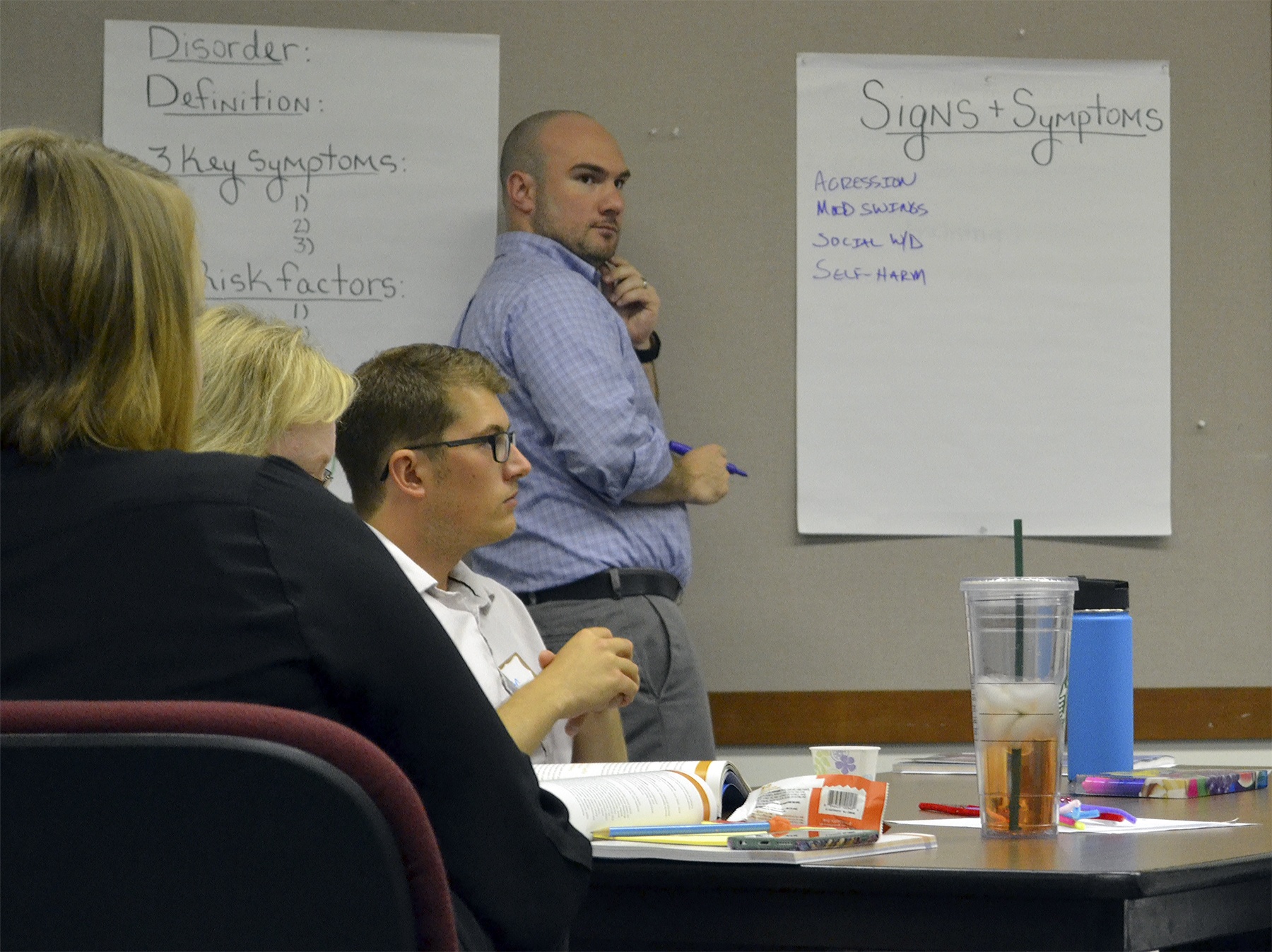MARYSVILLE – First Aid is important to know when working with young people. But society is beginning to realize that Youth Mental Health First Aid is also important.
Josh Webb, the Marysville School District’s mental health expert, taught two one-day classes on that topic this week to teachers and others who work with kids. Webb said the district already was planning to address this issue, but it became even more important after the Marysville-Pilchuck shooting two years ago. “After the crisis there’s been even more desire,” he said.
The district has put on about a dozen similar classes, and Webb said it is planning to open them up for parents and the public. He said it is important that more people learn about mental health to de-stigmatize it so people will feel comfortable talking about it. Mental disorder affects thinking, emotions and behavior. It disrupts the ability to function.
Remember the acronym ALGEE when dealing with a youth in crisis.
(A)ssess for risk of suicide or harm.
(L)isten nonjudgmentally.
(G)ive reassurance and information.
(E)ncourage appropriate professional help.
(E)ncourage self-help and other support strategies.
Webb also is excited about a Mental Health in High School curriculum that MSD is “considering rolling out this year.” The goal is to destigmatize mental health issues and “increase help-seeking behaviors.”
“I’ve seen a lot of positive trends,” Webb said about mental health. “We’re more willing to educate and not be afraid of labels.”
Traci Carter, a Catholic Community Services counselor, decided to take the class to “help my kids more.” She said she has noticed more kids affected by the shooting.
She mentioned how, especially with challenging changes during adolescence, it can be hard to tell if there are mental health issues because teens have so many emotions. But in dealing with them it’s better to error on the side of caution.
Counselor Madysen Pruss showed a video about Kevin Hines, who was diagnosed as bipolar at age 17. He developed extreme paranoia and thought, “Everyone was out to get me.” He didn’t tell anyone for fear he would be locked up. But some of the things he did to cope were things others did who aren’t bipolar: Sleep in the back of the class, act crazy, binge drink until he blacked out, etc. That was an example of how it can be hard to tell the difference.
At the seminar, each table was given a different mental health problem to study.
Their findings:
Anxiety – Many different types, including OCD and phobias. An example is to worry so much it affects the ability to cope. Risk factors include being a woman, genetics and trauma.
Bipolar – Can be genetic, but is one extreme to the other, from depression to high-energy levels.
Depression – Mood affects ability to do things. Signs include sensitivity, lack of energy and family history can play a part. Webb said people who are not depressed can bounce back with resiliency to be even stronger.
Eating disorders – Can be large weight gain or loss. It can be biological. It can be caused by abuse and low self-esteem.
Substance use disorders – Genetics can lead to addiction. Parents and peers can make it seem the norm. “If the parents have used, it’s normal for them,” Webb said.
Webb asked the class how it would explain mental disorder to a child of 5. The first response should be how they came to ask the question. An adult could provide more of an answer than the child seeks. Beyond that, compare it to a child having an illness or allergy. Sometimes it’s bad, and they need help, but other times they’re OK.
When trying to help a child with mental health issues, a key is to listen nonjudgmentally. They need empathy not sympathy. Walk beside them, don’t feel sorry for them. Don’t correct. Let them open up and be supportive. Don’t compare your past, but make it about them: reassure, normalize the situation, give them hope, don’t make promises you can’t keep or give advice.
Norms that may not mean mental health problems
•Question authority
•Own beliefs
•Care about height and weight
•Feel more intensely
•Quick to change emotions
•Taking risks
•Peer pressure means more
•Experiment social and cultural identity.
Statistics
•12 percent of girls have depression, compared with 4 percent of boys. Reasons include: Boys don’t talk about how they feel, and girls have more societal pressures on them.
•At age 12, 4 percent of all kids have depression compared with 11 percent at age 16. Reasons include: puberty and hormones, relationships, academic pressure, sports, driving, jobs… “It’s a huge cultural shock,” Webb said. At 12, “You’re still having fun being a kid.”
•Anxiety with a median age of 11 and eating disorders at age 15 are the most likely mental health issues in K-12.
•In 9th through 12th grade, almost one-third of students have issues with anxiety.
•41 percent of all people who have been diagnosed with a disorder are not treated.



